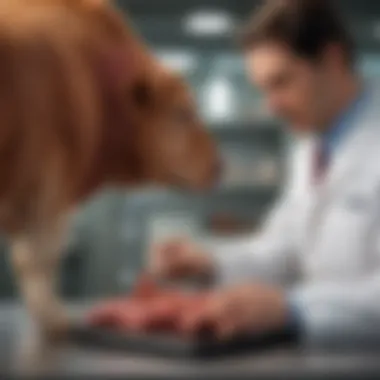Exploring the Risks of Feeding Raw Beef to Dogs


Intro
Feeding raw beef to dogs is a controversial topic that generates much debate among pet owners, veterinarians, and canine nutritionists. Many pet lovers often inquire about the health implications, nutritional value, and safety associated with a raw beef diet. The intention behind this inquiry is typically not only to optimize the health of their pets but also to provide a diet that aligns with their natural instincts. Therefore, an understanding of the nutritional intricacies, potential risks, and practical approaches in feeding raw beef becomes essential for anyone seeking to make informed decisions for their canine companions.
Nutritional Considerations
When assessing the merits of raw beef in a dog’s diet, one must consider the nutritional profile it offers. Raw beef contains several vital nutrients, including:
- Protein: A primary component for muscle development and maintenance, protein is crucial in a dog's diet.
- Fats: Raw beef provides healthy fats that contribute to skin and coat health, as well as energy needs.
- Vitamins and minerals: Beef is a source of essential vitamins like B12, iron, and selenium, all of which play critical roles in a dog’s overall health.
While raw beef can supply many essential nutrients, it should not singularly constitute a dog's diet. A balanced offering should include various protein sources and supplemental nutrients to address the requirements of canine health comprehensively.
Health Risks
Despite its nutritional benefits, feeding raw beef poses potential health risks to dogs. Owners must be aware of:
- Bacterial Contamination: Raw beef may carry bacteria such as Salmonella or E. coli, which can lead to serious health issues not just for dogs but also for humans in close contact.
- Nutritional Imbalance: Relying solely on raw beef may create an unbalanced diet lacking in vital nutrients. Dogs require a diverse range of nutrients to function optimally.
- Parasites: Raw beef can harbor parasites that are harmful to dogs. These can lead to conditions such as gastroenteritis or more severe illnesses if left untreated.
Educating oneself about these risks is pivotal. Consulting with a veterinarian or canine nutrition expert can provide tailored guidance regarding a safe and balanced diet.
Practical Guidelines for Pet Owners
For those interested in integrating raw beef into their dog's diet, some practical guidelines can ensure safety and health.
- Quality of Meat: Always opt for high-quality cuts from reputable sources. Grass-fed or organic beef is often recommended to minimize exposure to harmful additives.
- Gradual Introduction: Introducing raw beef to a dog’s diet should be done slowly. Sudden changes can lead to gastrointestinal issues.
- Proper Handling: Practice safe food handling techniques, such as keeping raw beef refrigerated and cleaning surfaces that come into contact with it to reduce contamination risks.
- Veterinary Consultation: Discuss dietary changes with a vet to confirm that they fit your dog’s unique health needs and conditions.
Ending
Feeding raw beef to dogs involves a careful examination of both benefits and drawbacks. While it may provide significant nutritional advantages, the associated health risks necessitate caution. A well-informed approach, ideally in consultation with a veterinary professional, can help pet owners navigate this complex issue and make sound dietary choices for their dogs.
Intro to Raw Feeding
Feeding dogs a raw diet has gain widespread attention in recent years. This approach reflects a return to more natural feeding practices. Many dog owners are curious about the implications of feeding raw beef and other raw meats. In this section, we will examine the significance of raw diets, focusing on the benefits they may present to dogs, as well as considerations that should be factored into the decision to adopt this feeding method.
Understanding Raw Diets
A raw diet typically consists of uncooked meat, bones, and organs, alongside some fruits and vegetables. This dietary choice is rooted in the idea that dogs, being descendants of wolves, would thrive on a diet that closely resembles that of their wild ancestors. Advocates of raw feeding argue that it may lead to better overall health, reflecting in improved vitality and appearance.
When evaluating a raw diet, one must take into account several aspects. The nutritional balance is crucial. Proteins, fats, vitamins, and minerals must be included in proper ratios. Poor planning can lead to deficiencies or excesses, affecting the health of the pet. It’s also essential to acknowledge that not all dogs may react positively to raw foods. Individual needs and health conditions can influence how a dog processes different food types.
Popularity of Raw Diets Among Dog Owners
The shift towards raw feeding has caught the interest of dog owners across the globe. A variety of reasons contribute to its rising popularity:


- Perceived Health Benefits: Many people believe raw diets can enhance their dog's digestion and energy levels. Owners report shinier coats and healthier skin when feeding raw.
- Control Over Ingredients: Pet owners appreciate the ability to choose high-quality meats and fresh produce. This has appealed to those who prioritize organic or free-range options.
- Critique of Commercial Dog Foods: Some owners raise concerns regarding the quality of commercial dog foods, citing issues with ingredients, processing methods, and nutritional adequacy. Raw diets are seen as an alternative to provide more wholesome options.
"Many dog owners are turning to raw diets not just for perceived health benefits but also as a way to gain control over their pet's nutrition."
Despite its increasing popularity, raw feeding is still a topic of debate among veterinarians and pet nutritionists. They emphasize the need for research and caution, as improper raw feeding can lead to health risks. To make an informed decision, it is crucial for dog owners to assess their dog’s specific nutritional needs, consult with professionals, and realistically evaluate the implications of such a diet.
Nutritional Aspects of Raw Beef
Understanding the nutritional aspects of raw beef is essential when considering it as part of a dog's diet. Raw beef is often praised for its high-quality protein content. Protein is crucial for muscle growth, repair, and overall health in dogs. This section will discuss essential nutrients commonly found in raw beef and how it compares with commercial dog food, providing a comprehensive perspective on its nutritional benefits and considerations.
Essential Nutrients Found in Raw Beef
Raw beef is rich in several vital nutrients. One of the primary components is protein, giving dogs the necessary amino acids required for their bodily functions. Amino acids support muscle development and repair tissues, which is particularly beneficial for active and working dogs.
In addition to protein, raw beef provides fats, primarily in the form of healthy omega-3 and omega-6 fatty acids. These are important for skin health, a shiny coat, and overall cellular function. Healthy fats in diets can also contribute to energy levels.
Not to overlook, raw beef is a source of vitamins and minerals. B vitamins, such as B12 and niacin, aid in energy metabolism, while iron supports the production of red blood cells. Zinc and selenium found in raw beef are significant for immune function and antioxidant defense.
"A balanced diet is key for maintaining dog health while minimizing nutritional deficiencies."
Comparison with Commercial Dog Food
When comparing raw beef to commercial dog food, several factors come into play. Traditional dog diets typically use a mix of meat, grains, and vegetable ingredients. However, there are key benefits of choosing raw beef.
- Ingredient Control: With raw beef, owners have direct control over the ingredient quality. Most commercial brands can contain preservatives or fillers that may not match a dog's dietary needs.
- Digestive Health: Many owners report that their dogs handle raw diets better than commercial options. Dogs may experience fewer digestive issues such as gas when consuming raw beef.
- Palatability: Raw beef can be more appealing to many dogs compared to dry kibble, leading to potentially better food intake and satisfaction.
However, it is vital to consider potential downsides of raw beef compared to commercial options. Commercially prepared food often comes fortified with additional nutrients, meaning the nutritional profile might be more balanced. This becomes crucial for dogs with specific dietary needs.
Ultimately, the choice between raw beef and commercial dog food should be made after careful consideration of the dog's overall health, lifestyle, and preferences.
Health Benefits of Raw Beef for Dogs
Feeding raw beef to dogs can offer several advantages, but it is essential to understand these benefits clearly. Raw beef is rich in protein and contains various nutrients that can contribute to overall pet health. Considering the raw diet as a whole can help owners make informed choices. These benefits are not merely anecdotal; they are supported by some scientific insights and experiences shared by dog owners who have transitioned their pets to a raw diet.
Improved Coat Condition
One of the most noted benefits of feeding raw beef is the potential for improved coat condition. Dogs that are fed a balanced raw diet often exhibit thicker, shinier, and healthier fur. This change is often attributed to the high-quality fats and proteins found in raw beef. Nutrients such as omega-3 and omega-6 fatty acids play a significant role in skin and coat health. When dogs consume these nutrients, their coat often becomes softer and less prone to excessive shedding.
Regularly feeding raw beef may also help alleviate skin issues in some dogs. Conditions such as dry skin or itchiness can sometimes be mitigated through dietary changes. Beef contains necessary vitamins that support skin cell turnover and repair. However, it is crucial to balance these nutrients to achieve the desired effects.
- High-quality protein sources contribute to hair follicle strength.
- Essential fatty acids maintain skin moisture and appearance.
- Reduction in allergens if beef is sourced properly.
"A healthy coat is often a reflection of a dog's overall health and nutrition."
Enhanced Digestive Health


Another important benefit of raw beef is enhanced digestive health. Raw diets usually result in firmer stools and more regular elimination. This change is due to the natural enzymes and bacteria present in raw meat, which can aid in digestion. Raw beef is less processed compared to commercial dog food, which can sometimes contain fillers that are hard for dogs to digest effectively.
Feeding raw beef encourages a dog’s natural chewing instinct. This behavior promotes saliva production, which aids in breaking down food before it reaches the stomach. Additionally, a diet rich in raw meats can help maintain a healthy gut flora. This balance can be vital in preventing gastrointestinal issues and ensuring optimal nutrient absorption.
Key points about enhanced digestive health include:
- Naturally occurring enzymes in raw beef can aid digestion.
- Firmer stools indicate improved digestive function.
- Reduction in allergies or intolerances with proper meat selection.
In summary, the consumption of raw beef may lead to visible improvements in a dog's coat condition and digestive health. Owners looking to enhance their pet's well-being must consider these potential benefits while being mindful of the inherent risks associated with raw feeding.
Potential Risks and Concerns
Feeding raw beef to dogs is a topic that raises significant questions among pet owners. Understanding the potential risks and concerns is essential for anyone considering this diet for their pets. While dogs are naturally carnivorous, raw diets can pose certain health hazards. This section elaborates on the key concerns such as bacteria and nutritional balance, which can severely impact the health of dogs.
Bacterial Contamination
Bacterial contamination is one of the most pressing concerns when it comes to raw beef. Raw meats often harbor pathogens that can cause illness in both dogs and their owners. The presence of bacteria like Salmonella and E. Coli in raw beef is especially alarming.
Salmonella Risk
Salmonella is a type of bacteria that can be present in raw beef. When ingested, it can lead to serious gastrointestinal issues in dogs, including vomiting and diarrhea. The key characteristic of Salmonella is its ability to survive in a range of environments, making it a frequent culprit in foodborne illnesses. For pet owners, understanding this risk is vital, as it not only affects the dog but also can pose a danger to humans through food handling practices. The unique feature of Salmonella is its potential to rapidly multiply in warm, moist conditions. This characteristic makes proper handling and storage crucial when feeding raw beef to dogs, as the risks can escalate quickly if not managed properly.
E. Coli Concerns
E. Coli is another significant bacterium found in raw beef. Some serotypes of E. Coli can be pathogenic for dogs, leading to severe health issues. The key feature of E. Coli concerns is its capacity to cause outbreaks, reflecting its potential danger. Unlike Salmonella, which is typically associated with improper cooking conditions, E. Coli can be present in both improperly prepared food and contaminated water. Its strength lies in how it can survive in adverse conditions. This makes it imperative for pet owners to be vigilant about their dog's health, even after initial feeding. The concerns surrounding E. Coli can deter many pet owners from pursuing a raw diet for their dogs, highlighting the challenges of balancing the benefits and risks of raw beef.
Nutritional Imbalance
A raw beef diet can also lead to nutritional imbalance in dogs. While raw meat can be part of a balanced diet, it should not be the sole component. Dogs require a mix of proteins, fats, carbohydrates, vitamins, and minerals for optimal health. Relying too heavily on raw beef can result in deficiencies, particularly in vitamins and minerals not found in sufficient quantities in beef alone, such as calcium and certain B vitamins.
Potential deficiencies can lead to a range of health issues. For instance, a lack of calcium may result in skeletal problems over time. Therefore, ensuring that the dog's diet is diverse and well-rounded is crucial. Pet owners should consider supplementing raw beef with other food items to achieve nutritional adequacy. This aspect of feeding raw beef can complicate matters, requiring careful planning and monitoring to prevent harm.
Guidelines for Feeding Raw Beef
Feeding raw beef to dogs is a subject that requires careful consideration. It can offer nutritional benefits, yet it also poses certain risks. Establishing guidelines for feeding raw beef ensures that both pet and owner are safe and healthy. These guidelines play a crucial role in making informed decisions about your dog's diet. They can help maximize the benefits while minimizing potential dangers.
Consulting with a Veterinarian
Before introducing raw beef into your dog's diet, consulting with a veterinarian is essential. This step allows pet owners to receive personalized recommendations based on their dog’s health status and dietary needs. Veterinarians can offer insights into the potential benefits of raw diets and advise on any existing health issues, such as allergies or digestive problems. This professional guidance is particularly important if the dog has pre-existing conditions or is on a special diet.
Moreover, veterinarians can help assess whether raw beef is suitable for your specific pet. They can suggest alternative protein sources if needed. Furthermore, a vet may provide tips on transitioning your dog to a new diet safely.
Choosing Quality Raw Beef
Selecting high-quality raw beef is a vital aspect of feeding your dog a raw diet. It is best to buy beef that is fresh and sourced from reputable suppliers. Grass-fed beef is often recommended due to its higher nutrient content. It is also essential that the beef has no additives or preservatives. This attention to quality helps minimize health risks associated with raw feeding.
Look for beef that appears bright red with minimal fat. The fat should be white or creamy. Avoid beef that looks discolored or has an unpleasant odor. Purchasing from local farms or trusted butchers can ensure the quality of the meat. Additionally, checking for certifications or reviews can provide reassurance regarding the meat’s quality.


Safe Preparation and Storage Practices
Proper preparation and storage of raw beef are crucial to avoid contamination and ensure your dog's safety. Always wash your hands, utensils, and surfaces before and after handling raw meat. Use separate cutting boards for meat and other foods to prevent cross-contamination.
When serving raw beef, cut it into appropriate sizes suitable for your dog’s breed and size. This approach not only makes it easier for the dog to chew but also prevents choking hazards.
For storage, keep raw beef in the refrigerator if it will be used within a few days. If not, freezing is a good option. Make sure to thaw frozen beef in the refrigerator or by using cold water, never at room temperature. Always keep your dog's feeding area clean to reduce the risk of bacteria.
Proper handling of raw beef can significantly reduce the risk of bacterial growth and diseases related to raw feeding.
Alternatives to Raw Beef
In the discourse surrounding canine nutrition, the consideration of alternatives to raw beef assumes pivotal significance. Owners who are wary of the potential risks associated with feeding raw meat, such as bacterial contamination and nutrient imbalance, may find solace in these alternatives. Providing suitable substitutes is essential for ensuring the health and well-being of dogs while also accommodating their dietary preferences.
Several options arise when contemplating alternatives to raw beef. These solutions can be categorized as either cooked beef or commercially available raw diets. Both choices offer distinct advantages and help address the nutritional needs of dogs in a manner that is safe and enjoyable for them.
Cooked Beef as a Substitute
Cooked beef serves as a pragmatic alternative for pet owners who prefer not to introduce raw meat into their dog's diet. It retains much of the nutrient profile found in raw beef while mitigating the risks associated with bacterial pathogens. Cooking beef allows for the elimination of harmful bacteria, rendering it safer for consumption.
However, proper cooking techniques are critical to maintain vitamins and minerals during the cooking process. Overcooking can result in unnecessary nutrient loss. Many dog owners choose to steam, poach, or bake the meat to achieve a balance between safety and nutritional preservation.
In addition to being safer, cooked beef can also improve palatability for some dogs. Not all animals are inclined to consume raw food, and cooked alternatives often entice dogs more readily. When preparing cooked beef, it is important to avoid seasonings or additives that could be harmful. Simple preparations, without extra spices or sauces, are the best practice.
Commercially Available Raw Diets
For those who want to embrace raw feeding but are concerned about meal preparation, commercially available raw diets present a viable solution. These products are often formulated to provide the necessary nutrients, balancing proteins, fats, and vitamins specific to canine health.
These commercial options can ease the transition to a raw diet. They minimize the risks of contamination by adhering to strict safety and handling guidelines during production. Reliable brands often supply frozen or freeze-dried raw food that is convenient for pet owners.
Selecting a reputable manufacturer is essential. Owners should opt for those that provide transparency regarding sourcing and nutritional content. Ingredients should be clear and not contain unnecessary fillers or additives. This approach ensures that dogs receive a balanced diet devoid of harmful substances.
The End
Concluding this discussion on feeding raw beef to dogs involves synthesizing the extensive information and practical guidance covered in the article. It is essential to understand that while raw beef can be a nutritious part of a dog’s diet, it comes with both advantages and risks. Pet owners must weigh these factors carefully, considering their dog’s specific health needs and lifestyle.
Summary of Key Points
- Nutritional Benefits: Raw beef is rich in proteins, fats, and vitamins that are valuable for a dog's health. It can enhance coat quality and support muscle development.
- Risks Involved: The potential for bacterial contamination, such as Salmonella and E. coli, poses significant health risks. Nutritional imbalances may also arise if a raw diet is not carefully planned.
- Expert Consultation: Prior to making any dietary changes, consulting with a veterinarian is crucial to ensure safe and beneficial practices.
- Alternatives Available: If raw beef seems unsuitable, cooked beef and commercially available raw diets can provide balanced nutrition while reducing risks.
"Vet approval is non-negotiable when considering raw feeding options for dogs."
With this knowledge, pet owners can make informed decisions that prioritize their dog’s health and well-being, while also considering the practicality and ethical implications of their dietary choices.
Final Thoughts on Raw Beef Feeding
Feeding raw beef to dogs can be a contentious topic among pet owners and veterinarians alike. It demands a careful evaluation of all aspects involved, from nutritional requirements to health implications. If you decide to proceed with a raw beef diet for your dog, ensure you invest time in education and preparation.
Understanding the balance between benefits and risks is critical. Regular monitoring of your dog's health and behavior is necessary, as changes in diet can have varying effects on different dogs. Make informed choices that reflect not only personal beliefs about feeding practices but also align with veterinary guidance and scientific research.
In summary, embracing a raw beef diet for dogs requires diligence, commitment, and an ongoing dialogue with veterinary professionals to ensure that you provide a safe and healthy diet.







